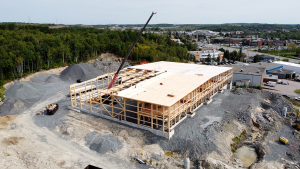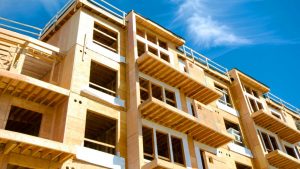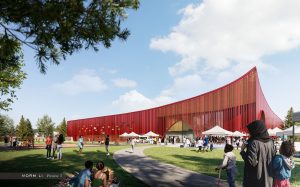Hurdles that mass timber faces to becoming part of mainstream construction were top of mind at a panel session at Summit 2024, a conference hosted by WoodWorks in Toronto recently.
At issue for developers is a lack of data to determine how much a mass timber building can rent or sell for, said Annabelle Hamilton, technical manager of planning and development with WoodWorks BC.
Mass timber can be a “risky environment” for developers and the revenue unknowns add a layer of uncertainty, the panellist told the audience at the summit held at George Brown College’s Waterfront Campus.
Adding risk are cost premiums over conventional construction which can stem from higher consultancy fees for mass timber, she said.
“We are in a pretty difficult climate from uncertainty on the revenue and the cost side.”
Uncertainty is compounded by a lack of people with experience to plan a mass timber building from excavation to occupancy, said Scott Cameron, director of SKOV Mass Timber, a consulting firm for developers and general contractors at the pre-construction stage.
“There are a lot of times when projects will end up back on the shelf and they (developers) will go back to concrete and steel.”
To avoid project stalls, know when mass timber has to be onsite and the dates when the supplier needs all of its drawings approved, he said.
Make sure the MEP partners have experience with timber or know the questions to ask about working with it, Cameron added.
Utility penetrations through CLT panels should be done in the fabrication plant but often MEP subs do them onsite, adding time and cost to the project.
Cameron told the seminar that fabrication plants needed to meet the growing demand for mass timber are in many cases five to 10 years away.
Insurance has often been another hurdle for the sector.
Panellist David Messer, director of the Climate Smart Building Alliance, noted a project where a builder had to secure a second insurance policy for about $600,000 on mass timber even though it only represented about $1 million of the $60 million build.
“It threw off the economics of the whole project.”
The root of the problem can be that insurers don’t have enough risk and loss data on mass timber, said Messer, whose company is a joint initiative that includes EllisDon, RBC, Atkins Realis and others focused on addressing barriers to net-zero buildings.
To minimize the problem, the Climate Smart Building Alliance is creating a database for mass timber projects.
Another issue insurers face is replacement or repair costs when a mass timber building is damaged by fire, smoke or water.
Messer said there is no rating system for contractors on mass timber projects as there is for contractors on conventional projects so insurers don’t know if the team has the experience needed to minimize project risks.
Another issue can be the uncertainty of the regulatory environment.
As a case in point, he pointed to a large mass timber development that went through several municipal regulatory changes over the project’s lifespan.
“Some of the changes required them (the developer) to make slight changes to the units and to the grid, which in conventional construction you can do quite easily but in this mass timber building were very hard to adapt.”
On a positive note, Hamilton said that bonus density incentives for tall mass timber projects are one municipal policy change at the City of Vancouver which help “derisk” the wood designs for developers.
One of the panellists, Kevin Grosskopf, who has experience in offsite modular construction, said lenders might adjust their combined loan-to-value ratios or interest rates for the added risk to insure modular products from jurisdictions outside their area of expertise.
Grosskopf, a professor at the University of Nebraska–Lincoln, Durham School of Architecture, Engineering and Construction and a licensed general contractor, told the audience there is a trend in the U.S. and in some Canadian hospitality markets for manufacturers to expand their roles to prime designer and even site installer to eliminate project uncertainties and control costs.











Recent Comments
comments for this post are closed